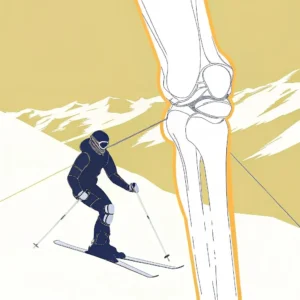
Banged Up My Knee While Skiing (ACL Injury)
I’d skied for years and years without ever really paying attention to my knees. I was young, resilient—I could hit big airs and wrench my joints just to pull off octograbs. Then one day, on the last session of the day, I hit one final jump in the snowpark: landing was perfect, but my legs were tired, and… CLACK.
The Fall
My knee didn’t bend the way it usually does—it bent inward, I unclipped, and I went crashing down. Sprawled out like a pancake on the landing, nobody saw me, but I felt it in an instant: something was broken.
And it HURTS. A LOT.
I still managed to ski down to the base on one ski. The pain was intense… I went to see the ski patrol for an opinion. They told me it was nothing, just some scrapes… Okay, let’s see in a few days.
A few days hopping around on one foot. Nothing too dramatic; bit by bit I got my mobility back.
Well, it turned out to be nothing!
False Alarm?
As days and weeks went by, there was little to report—some pain and trouble straightening my leg, but really, nothing alarming. Until the day I decided to see a physio, because I still needed to get this knee bending properly again.
After asking me about what had happened, the physio casually said, “Could be a torn ligament…” I couldn’t believe my ears. After the ski patrol and even a GP had checked me, none of them suspected a ligament tear. Really strange.
Verdict
Unfortunately, the verdict came after a scan. Yep: complete tear of the ACL (anterior cruciate ligament). On top of that, a fracturing of the tibial plateau and a mangled meniscus with a “flap” that would need to be removed.
That’s when the real ordeal began.
Surgery was scheduled for several months later. They told me to bulk up my legs—especially my quads—because I’d need them for rehab and to minimize muscle loss during three weeks of immobilization.
Finally, surgery day arrived. Everything seemed to go smoothly; it took less than two hours. Done.
A bit loopy, I even watched the procedure on a screen. Strange sensation.
That very evening I went home thinking it wasn’t so bad. But then the painkillers and anesthesia started to wear off.
My knee was on fire, and my leg was locked into a massive brace. Things got complicated.
Rehabilitation
The first night was a long one; every little movement in bed jolted me awake. The very next day, we started the first rehab exercises at home. The physio came over and twisted my knee and leg every which way. Pain: 10/10.
That level of pain is surprising but can happen. Still, it was quite a shock—physio said it should improve slowly and that regaining flexion and extension ASAP was crucial.
Days passed, flexion improved, but we were far from goals—those stubborn extra degrees needed to fully bend and straighten my leg were still missing. It felt like something was stuck inside my knee.
Weeks went by, rehab sessions continued, but honestly, progress was at a standstill. Sure, I could walk and even jog, but it hurt whenever I had to fully extend my leg—a movement you make constantly without even thinking.
Monthly visits to the surgeon showed no real improvement; he just jabbed a 20 cm needle into my knee for an injection.
Nice. Effective for twelve hours, then back to square one—the pain returned.
Like a glitch.
Well, this knee turned out to be one hell of a headache… Am I a bad patient? Not stretching enough, not doing enough strength work? Or did the surgery botch it?
At six months I still had hope, but honestly, I was still in pain. The others who’d had surgery the same day as me were bounding around like rabbits, while I hobbled and complained constantly.
Finally the surgeon agreed to another scan; he didn’t really believe me when I said it still hurt… Was I imagining it? I began to doubt myself.
Second Surgery
But surprise—there it was on the scan! A bit of bone—a “flake” of bone—that hadn’t been properly cleaned out during surgery and had been floating around in my knee joint for six months.
Basically, every time I walked it was like a grain of sand in the gears: it stuck, it rubbed, and it hurt…
So yes, the initial surgery really did botch it. It wasn’t imaginary pain!
A second, much smaller surgery was scheduled a few weeks later to remove that annoying foreign body via a tiny incision.
And indeed, just hours after the anesthesia wore off, I felt alive again. The pain vanished immediately!
That long rehab ordeal—three weeks on crutches, then painful physio and strength work—finally paid off.
I felt ready, after almost a year.
A year of almost no sports, thinking only about rehab, thinking only about my knee—and always with the hope of getting back on skis soon.
The injury happened at the end of March; I was finally ready the following March!
The Invisible Injury
But in reality, the injury wasn’t fully behind me yet. The invisible injury was the mental one: fear.
After months of fighting to regain decent physical shape—making sacrifices and enduring pain just to ski again—nothing felt guaranteed, nothing was easy.
So when I finally stood at the bottom of the slopes again, a huge hesitation set in. And what if…
What if my knee hadn’t healed properly?
What if I fell? Silly, right?
What if, on a harder turn, my knee suddenly gave way?
What if, what if…
So you go slowly, you hesitate, you don’t want to push it. The first little jumps felt like breath-hold dives. You think, let’s see how that landing goes.
This phase of uncertainty can last a long time; for me, it lasted months—easily nearly a full season.
This struggle is something doctors don’t talk about, yet it’s very real and you have to prepare for it. To be willing to take risks again, you also have to accept the chance of getting hurt—same knee or the other one?
Actually, it’s also possible everything goes fine, you know.
And that it’s all behind you—but it’s hard to just forget such a painful, tedious, and long ordeal.
You don’t want another month on crutches, another six months of rehab, and two surgeries just to do 360s and cork 7s.
Is it really worth it? Well, yes.
Acceptance
In life, as on skis, we take risks to move forward, to experiment, to discover, and simply to enjoy ourselves. Even if you’re not chasing top-level performance, injuries are part of skiing—and most sports—where there’s any real commitment and exposure.
So you have to accept that you might get hurt, and get hurt again, to give 100%—on and off the slopes. Injury isn’t fate, but it’s always close enough to remind you to stay in line.
What’s the lesson in all this?
- You’re not indestructible.
- Don’t try anything crazy at the end of a ski day.
- If you’re tired, listen to your body.
- Confidence eventually comes back…
- Be patient. Very patient.
Taking risks is part of life. Facing the consequences is too!



Your comments and questions